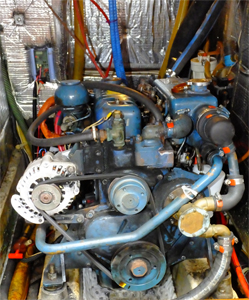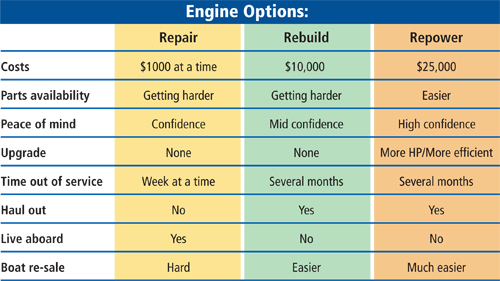When you have an older boat like we do — a 1987 Moody 422 sloop — and you’re living aboard and cruising it full time, the process of repairing and replacing gear is part of life. We’ve replaced sails and electronics over the years. We bought a new dinghy and replaced the outboard. We’ve put in a new complement of batteries twice already and upgraded wiring and solar panels. We’ve replaced yards of line and pounds of hardware. But now we are facing a very tough decision — the main engine.
We consider our main engine a vital piece of safety equipment. Yes, we are a sailboat and we try to sail as often as we can, both because we enjoy it and it saves fuel costs. But there are times when running the engine is critical: when you know bad weather is approaching and you can motor your way clear; when a narrow atoll entry requires an engine that will get you through the pass safely; and simply working your way into an anchorage and setting the hook. For all of these situations, a solid engine is essential.
Our engine is a 50-hp Perkins 4-108 built in 1987. We aren’t quite certain how many hours it has because when we purchased the boat in 2004, there was no hour meter and we’re the third owners. We put an hour meter on and have added almost 3,000 engine hours since we’ve owned it. Over the last three years it seems we have been putting more and more dollars into repairs.
Now we have a few more issues looming large and we are asking ourselves the big question: “Do we continue to repair it, rebuild it, or do we bite the bullet and buy a new engine?”
Repair
You do this whether it’s a new motor or a good old workhorse engine. Things break or wear out and need to be replaced. We have lots of spares for our engine aboard and Michael is capable of doing most of the repairs himself. It’s when the big issues come up that we bring in the experts — and in remote places this is often difficult (if even possible) and usually expensive.
Getting parts for an engine that is 28 years old can sometimes be an issue. We checked on a new starter and the only way to be certain it would be the right one was to send our old one in to the parts company. We were in New Zealand at the time and dealing with a U.S. supplier, so the cost of shipping back and forth would have been both very expensive and time consuming. We opted to have the starter rebuilt at almost the same cost as a new starter minus the shipping. We are still not certain the rebuild was done correctly.
We looked at all the major repairs we have done over the years as part of our analysis for this “big” question.
Before leaving, we put on a new transmission and damper plate. In the last six years of cruising we have done the following major repairs on our engine: replaced fuel lift pump; new main rear and front oil seal; rebuilt fuel injector pump; injectors serviced; new high pressure fuel lines; new motor mounts; new raw water pump; two new alternators; heat exchanger core cleaned and tested; and exhaust mixing elbow replaced twice.
When these repairs are amortized over all the miles under the keel, this has not been too extreme. One mechanic we trusted in the U.S. once told us, “A good diesel engine will corrode out before you wear it out.” And though the repairs hurt every time we clunked down a thousand of our favorite American dollars (it always seems to be at least $1,000), it is a chunk spread out over time. It may be $1,000 at a time — but that may be easier to swallow than a lump sum of many thousands to rebuild or buy a new engine. Repairing usually means only a short time out of commission to do these repairs.
Looking back over the six years of cruising, having tracked each dollar we spent, we spent around $8,000 on parts and mechanics for the main engine alone. That does not include all the spare parts that we used on it that we already had on board before departing Florida in 2009. It also does not include the consumables like oil or filters, which we would use on a new or old engine. Amortized over the six-plus years of sailing, we are probably spending about $1,500 a year on main engine repairs. Would investing in a new engine cost us less annually over the long run, and would we see those savings or will the next boat owner reap the benefits?
Peace of mind is probably the biggest concern with this “repair” option. As we write this, we are at a very remote island in the Banks Islands group of Vanuatu. There are no repair facilities or parts around — the closest is a plane ride away. The engine has a cooling water leak and a small diesel leak on the injector pump. We don’t want to mess around with the engine too much here, but we still have a long haul to get back to New Zealand and don’t want to do that passage with a dodgy engine. So we will have to invest some repair dollars in hopefully solving these problems while still in either Vanuatu or New Caledonia.
 |
|
Sobocinski’s partner Michael Hawkins works on the Perkins. |
Rebuild
The Perkins 4-108 is a solid engine. Parts are still relatively available, though the places to get them are becoming more limited with each passing year. Mechanics can usually be found in most locations that know this motor. So, our second option is to have a total rebuild, top to bottom, of our existing engine.
We carry lots of spares for this engine, so a rebuild would save us having to buy new spares for a newer and different engine. Michael has worked on this engine quite a bit and knows it pretty well so there would be no new learning curve for him.
The key to the rebuild will be finding someone who can do the job so we have confidence in the work. Someone we can trust. We’ve had both good and bad experiences with mechanics over our six years of cruising. Finding someone willing to take on this project who is capable of quality and timely work will be the single largest challenge in this option.
The cost of this more major “repair” is also a factor. We estimate that the cost will be around $10,000 for a major overhaul. That is not a hard number, just an estimation for our thinking process. Of course, the price will adjust after a diagnostic of the engine determines how deep we need to go. Before we make a firm decision, we need to get more accurate numbers, then add 25 percent for the “unforeseen” extras. We will also have to be out of the water and out of commission. Because the boat is our home, living aboard during a major rebuild will also be tough. There may be additional costs with finding a home away from our floating home.
A well-done rebuild should give us the peace of mind to head into even more remote locations. The key will be finding the right person to do the job while in New Zealand — there at least we won’t have a language issue complicating the process.
Repower
This is the big pill to swallow. It is a big chunk of money in one fell swoop. We are on a cruising budget and that is always a hard thing to accommodate.
Though there are never any guarantees, we know that with a new motor we would feel more confident in remote locations. Plus the new motor will come with some warranties. The good news is we could also upgrade our horsepower. Currently, we feel slightly underpowered with the 50-hp engine. We probably could also save some money on fuel and oil with a more efficient power source. The updated engines are also better equipped to handle some of the newer low-sulfur and bio-diesels that seem to be more prominent — and often the only option — in various locations. We most likely will also save a few pounds of weight aboard with a more efficient newer engine.
The hardest part will be fitting a new engine on the existing engine room platform. Though engines are now smaller and more efficient than 28 years ago, the boat was constructed with the braces and mounts for our current Perkins engine. The good news about a replacement motor will be the opportunity to totally clean out the engine room, repaint it and make the most efficient use of the space.
Besides the cost of the actual new engine, there are many more costs associated with a repower. New fuel lines, hoses, wiring, shaft, an exhaust system and, of course, spares. New belts, filters and backup parts will need to be added to the spares locker. Add the cost of the haul-out, shipping, finding a place to lie our heads while the work is being done and the cost of a mechanic, and the price tag gets mighty hefty. What is a reasonable price for more power and peace of mind?
Again, our price on the engine is a rough estimate; as we get closer to making a decision, we would have a firm negotiated price tag. It’s hard to get prices in the remote islands! We spoke with one mechanic and he said to double the price of the engine to include the installation. Of course this is most likely to have the mechanic do all the work. In our case, Michael would do a lot himself and use the mechanic for his expertise. So perhaps we wouldn’t have to quite double the price.
Are we overreacting with even thinking about repowering? We repowered our last boat and felt like it was a mistake. We sold the boat within a few years of repowering. The new owners got the benefit. We got the bill.
We know this boat will be our home for as long as we decide to continue cruising. We are still enjoying the experience and plan on a few more years. After we’re done cruising, we’ll sell this boat and get something smaller. We decide annually if we’ll continue cruising and if so, where we’ll go. If we stay in the South Pacific region, making the run between New Zealand and the islands, the “repairs” options makes the most sense. If we want to venture into Indonesia and beyond, we would be more confident with at least a rebuild. Or should we just go ahead and upgrade with a newer model engine? We know we won’t get the money out of a new engine when we sell, but perhaps it will speed the sale.
Barbara Sobocinski and Michael Hawkins live aboard their Moody 422 sloop Astarte. Since leaving St. Petersburg in February 2009, they have explored the Caribbean and the Pacific.
 |
|
A summary of the pros and cons of the three engine options. Repowering has the most positives but also the highest price. |

